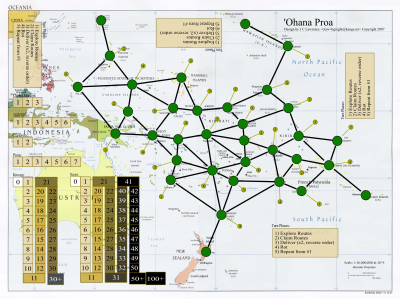I’ve decided to use stacking plastic counters for markets (they’re small discs with a central dome that stack well, similar to the damage markers in Heroscape)

They’re readily available in large quantities and in multiple colours from educational supply stores.
As they’re not very small (12mm is the smallest I’ve found) I’ll need to increase the island size to accommodate, probably to 20-25mm. I’ll then need to make the map bigger in response , and this will allow me to hang a staging circle off each island (essentially a circle connected by a differently coloured non-route). Bingo! Instead of the market development charts I can use stacks of tokens on the staging areas for each island. They’re visually distinct from the islands and yet obviously connected. The islands also won’t need to be numbered any more. Good stuff.
While I don’t intend to use them (see prior post), these would make good fish counters (even better if they were not red):

They’re called “bean counters” and are also available from many educational supply stores.
Other items:
1) There’s a problem with the numbers. A 1 VP kula item can be bought with 2 fish. 1 VP may be discarded for 3 fish. Ergo making kula items from VPs is more efficient than from natural fish, and in turn players may as well concentrate almost exclusively on shell routes as soon as they can. Not good. I could simply drop the exchange for VPs down to 1:2 for fish, but that has nasty effects on proa costs (5 fish or 3 shells) and the rules forcing players to discard VPs to buy proas. The proa cost ratios are fairly carefully weighted for the behaviours I want and changing them won’t be pretty. Damn.
2) What to do if players collusively hoard fish by exchanging them with each other in faux auctions? Eventually the game will run out of fish? Possible addresses:
- Force higher rot rates for players with many fish
- Players sopposed to receive fish take them from players with more fish
- Allow shells to be taken instead of fish and possible allow shells to be cast down into fish
The third option is the most attractive and the most unsettling. It adds a flexibility to the split economies which I’m quite uncomfortable with. A core assumption of the game to date is that fish and shells have very limited fungibility.
3) The game ending rules have a logical gap when the last market of a colour can’t be delivered because the destination is more than 7 proas away, or it is simply the last market of that colour on the board. This is a problem given that markets may satisfied at values of 3, 4 or 5 – there will be stragglers. A rewrite of that section is in order.
4) I’m still waiting for #4 but I don’t think I’d recognise it if I saw it.



